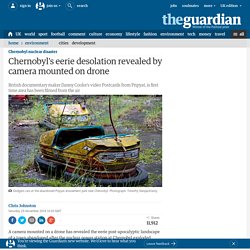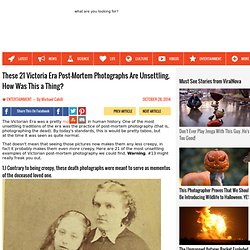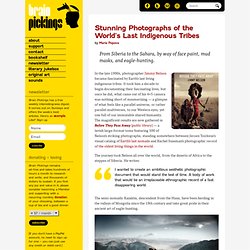

High-speed photos of ink dropped in water. Chernobyl’s eerie desolation revealed by camera mounted on drone. A camera mounted on a drone has revealed the eerie post-apocalyptic landscape of a town abandoned after the nuclear power station at Chernobyl exploded nearly three decades ago.

The British documentary maker Danny Cooke has travelled to Pripyat, just a few miles from the power plant, which was once home to 50,000 people. It was evacuated soon after the disaster on 26 April 1986 that killed 31 people and sent large quantities of radioactive particles into the atmosphere over the western part of the then Soviet Union and Europe as far as away Wales. His video, Postcards from Pripyat, Chernobyl, marks the first time the area has been seen from the air. He shot the footage while working on a segment for US current affairs programme 60 Minutes on CBS, which was broadcast last week. Cooke’s haunting three-minute film shows sights such as a Ferris wheel in an amusement park quietly rusting away. These Examples Of Victorian Post-Mortem Photography Are Unsettling. The Victorian Era was a pretty morbid time in human history.

One of the most unsettling traditions of the era was the practice of post-mortem photography (that is, photographing the dead). By today's standards, this is would be pretty taboo, but at the time it was seen as quite normal. That doesn't mean that seeing those pictures now makes them any less creepy, in fact it probably makes them even more creepy. Here are 21 of the most unsettling examples of Victorian post-mortem photography we could find. Warning. #13 might really freak you out. 1.) 2.) 3.) 4.) 5.) 6.) 7.) The most iconic photos in history recreated in impressive live action. Re-created Photos (Partial List) "Raising the Flag on Iwo Jima" by Joe Rosenthal Photographs of the Apollo 11 moon mission "Migrant Mother" by Dorothea Lange "Le Baiser de l'hôtel de ville" by Robert Doisneau "Rue Mouffetard, Paris" by Henri Cartier-Bresson.

Stunning Photographs of the World’s Last Indigenous Tribes. By Maria Popova From Siberia to the Sahara, by way of face paint, mud masks, and eagle-hunting.

In the late 1990s, photographer Jimmy Nelson became fascinated by Earth’s last living indigenous tribes. It took him a decade to begin documenting their fascinating lives, but once he did, what came out of his 4×5 camera was nothing short of mesmerizing — a glimpse of what feels like a parallel universe, or rather parallel multiverses, to our Western eyes, yet one full of our immutable shared humanity. The magnificent results are now gathered in Before They Pass Away (public library) — a lavish large-format tome featuring 500 of Nelson’s striking photographs, standing somewhere between Jeroen Toirkens’s visual catalog of Earth’s last nomads and Rachel Sussman’s photographic record of the oldest living things in the world. Incredible Photos of People Living Off The Grid Who Abandoned Civilization fo... Photographer Antoine Bruy not only traveled and lived with off-grid families for three years, but captured captivating photos of their Walden-esque existence.

When screeching city noises and demands from the 9-5 job become too much, most people can only dream of what quiet isolation in the rural countryside could be like. But French photographer Antoine Bruy turned that dream into a reality by hitchhiking across Europe from 2010 to 2013. The artist wandered through remote mountain regions without any fixed destination or route in mind, but along the way met several individuals who had willingly abandoned hectic city life in exchange for retreat in the deep wilderness.
These people sacrificed modern comforts for greater autonomy and freedom, and in result became inspiration to the inquisitive photographer. Image Credit: Antoine Bruy In Bruy’s series Scrublands, he documented the homes and faces of the people he countered, by chance, who live far away from civilization. An 83-Year-Old Photographer Found A Box Labeled “Mothers” Full of Images He T... Ken Heyman, a renowned and award-winning people photographer, recently uncovered a nearly forgotten treasure in storage – a box labeled “Mothers” that had a beautiful series of images that he shot of mothers around the world nearly 50 years ago.

The 83-year-old photographer shot the images for Family, a book that he co-authored with renowned anthropologist Margaret Mead in 1965. Margaret Mead had been his professor at first, but they later wound up working together on this and other books and projects. Their anthropological collaboration is apparent in the images, as they document motherhood around the world, not just from any one culture’s perspective. More info: kenheyman.com (h/t: huffpost) The beautiful surreal worlds of Erik Johansson. Once You See These Rare Historical Photos, You’ll Never Forget Them, Especial... May 062014 Like some of you, I’m also a rabid history buff, specializing in collecting the most interesting rare historic photos.

I only curate the rare ones that have a significant impact on the history of the world. Find out below some of the most fascinating rare historical photos ever captured on camera. Thanks to these great images, we now have before us a rare window to some of the most interesting moments of our world history. 1. 2. 3. 4. 5. 6. 7. 8. 9. 10. 11.